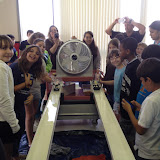The fifth annual “Engineering Family Fun Day” will be held Saturday, November 3 from 10AM – 2PM in Dreher Park – Pavilion 3 (across from the Dreher Park Zoo) in West Palm Beach. Palm Beach County students, along with their families, teachers and counselors will enjoy a fun filled and educational event. The events’ main focuses are on educating the community on the opportunities available in engineering and inspire an interest in the areas of math and science in students from 4th to 12th grade.
The Society of Women Southeast Florida Section and the Palm Beach Alumni Extension of the National Society of Black Engineers are co-hosts. This event will increase the students’ as well as their parents’, teachers’, and counselors’ awareness and knowledge of engineering and other technical fields.
The event will involve eight booths. Each sponsored booth will present a hands on engineering related activity by which the students, parents, and engineers can interact with each other. For example the Bottle Rocket involves aerospace engineering and Making Polymers involves science and chemistry.
The EF2D event involves sponsored booths. Each sponsor presents a hands on engineering related activity by which the students, parents, and engineers can interact with each other. For example, the Bottle Rocket booth teaches students aerospace engineering and the Making Polymers booth involves chemistry. Last year, Seminole Ridge SECME students challenged children to learn the physics of projectiles by making a popfly launcher with paint stirrers, a PVC pipe coupler and a ping pong ball. The minicatapults were sponsored in part by Lowe's Home Improvement of Royal Palm Beach, store #0654.
This year, Seminole SECME will make magnetic field maps of Mars. Then the participants make "field detectors" from simple objects to predict the locations of the fields. The big idea of this demonstration is that the Sun and planets have different
magnetic properties. Sunspots are related to magnetism on the sun. Earth has a
strong simple magnetic field with two poles. But Mars has no magnetosphere!
http://www.nasa.gov/audience/foreducators/topnav/materials/listbytype/Solar_System_Magnetism.html
http://mgs-mager.gsfc.nasa.gov/kids/magfield.html
(Click on the first picture to flip through a photostream of 2011 EF2D)

We challenge you to…
…build a device that can that you can pass above a surface and detect magnetic fields.
1. Brainstorm and Design
• How can you make sure that the metal shards stay in your detector and not fall off?
· How can you make it easy to see when the metal shards move?
· How will you hold the detector as you move it above the surface?
2. Build
Invent your own designs.
3. Test
· Try out your detector. At our booth, use the small magnet to test how well your detector works.
· Find the hidden magnets. Take your detector to the newspaper grid. (it represents a map of Mars' surface.) Find the magnets by slowly passing your detector over the grid, one section at a time.
· Map the magnets. Using the grid lines to identify the locations, mark each magnet with a dot on your map (NOT on the newspaper).
4. Evaluate and Redesign
· If it’s hard to see the shards move… Design a window or remove parts that block your view.
· If your detector doesn’t respond… Check that you have enough metal shards and that nothing is interfering with how they move. Also check that you’re not holding it too far above the surface.
5. Go Further
- Upgrade your detector. Make it sensitive enough to work six inches above the surface.
- Magnet Treasure Hunt. You’re surrounded by magnets! Use your detector and see how many invisible fields you can find. Check things like speakers and electric motors.
 http://pbskids.org/designsquad/pdf/parentseducators/dsn_nasa_missionsolarsystem_complete.pdf
http://pbskids.org/designsquad/pdf/parentseducators/dsn_nasa_missionsolarsystem_complete.pdf






